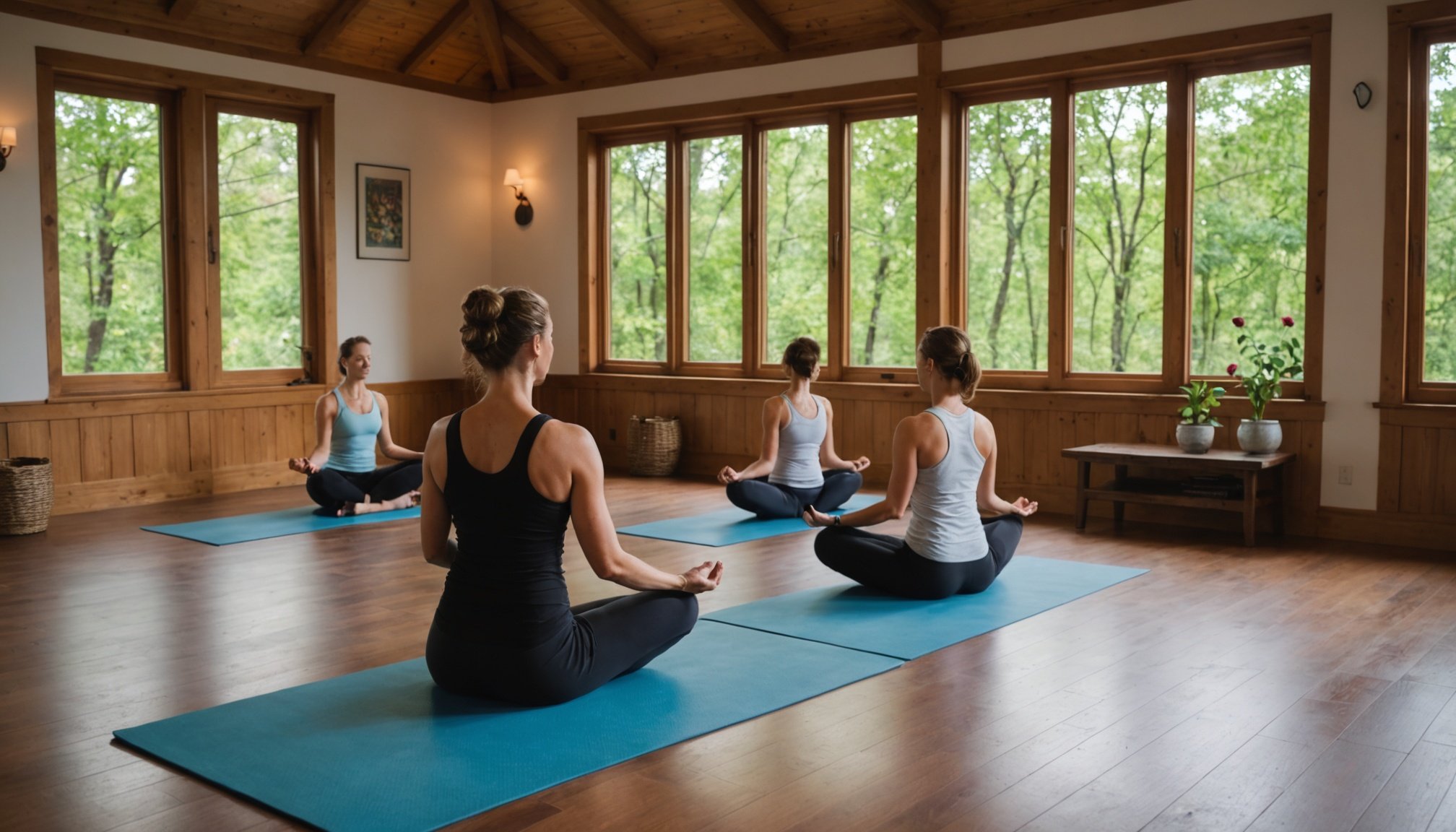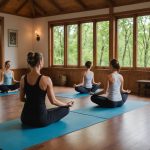Creating the Right Space for Yoga Practice
Crafting an ideal yoga environment at home starts with careful space design. Begin by decluttering to foster a sense of calm. Remove unnecessary items, creating room both physically and mentally. A well-organized space enhances focus during your practice.
Selecting appropriate furniture is also crucial. Opt for minimalistic pieces that do not disrupt the flow of movement. Consider a soft mat or a small stool that can double as storage. Arrange furniture to maximise space, providing the freedom to move freely without obstacles.
In parallel : The definitive handbook for selecting trendy and cozy shoes for extended commutes
Natural light is a critical element in setting a serene atmosphere. Position your yoga area near a window to flood the space with gentle light. Not only does sunlight lift spirits, but it also aligns with yoga’s holistic approach, promoting well-being. Equally important is ensuring good airflow. Open windows or use fans to maintain a fresh environment conducive to relaxation and concentration.
By focusing on these elements, you create a harmonious setup that enhances the effectiveness of your home yoga sessions. This approach not only supports physical practice but nurtures mental tranquillity, ultimately enriching your overall experience.
Topic to read : Mastering Minimalism: Create a Chic Wardrobe That Elevates Your Style
Enhancing Ambiance for Mindfulness
Creating the perfect ambiance is crucial for cultivating mindfulness, and it starts with subtle adjustments in lighting, colours, and scents.
Choosing the Right Lighting
The role of lighting in setting the mood cannot be overstated. Soft, warm lighting is pivotal in crafting a calming environment, as harsh lights can be distracting and jarring. Consider using lamps with dimmers or candles to provide gentle illumination. An often-overlooked tip is to utilise natural light when possible, which invigorates and soothes simultaneously.
Selecting Calming Colors
Colours have profound psychological impacts that can affect one’s mood and mindset. Opting for soothing tones such as soft blues, greens, and pastels can evoke calming sensations and aid in relaxation. Color psychology suggests these hues promote peace and clarity, which are essential for mindfulness.
Incorporating Scents and Aromatherapy
Scents can profoundly influence atmosphere and mental well-being. Incorporating essential oils or incense such as lavender or chamomile can lead to enhanced relaxation and tranquillity. Simply diffusing these scents or using scented candles can transform a space into a sanctuary, promoting a mindful and serene atmosphere.
Essential Yoga Props and Accessories
Incorporating the right yoga props can significantly enhance your practice, providing both support and comfort. Essential props like mats, blocks, and straps are fundamental. A good quality mat not only offers stability but also ensures safety during poses. Blocks, often made from foam or cork, assist in achieving the right postures, especially for beginners. They bridge the gap between your body and the ground, making challenging stretches more attainable.
Straps are another crucial accessory. They aid in stretching, improving flexibility without straining muscles. For those who find certain poses difficult, straps extend the reach, allowing for more precise positioning. Blankets, while sometimes overlooked, provide a layer of comfort during seated positions or as extra support in restorative poses.
When selecting these accessories, quality should be a top priority. Durable materials ensure longevity and effectiveness. Investing in reliable yoga props can enhance your practice’s efficiency, enabling smoother transitions and reducing the risk of injuries. Overall, these comfort items are not just about convenience, but they also contribute to a more enriching yoga experience.
Incorporating Nature Elements
Bringing nature into your home can have significant benefits for both your environment and well-being. Indoor plants are not only visually pleasing but also improve air quality. They act as natural air purifiers, removing toxins and increasing oxygen levels. This can lead to mood enhancement, helping reduce stress and promoting a sense of calm.
Utilising natural elements such as wood and stone in your decor can add warmth and texture to your surroundings. These materials reflect the beauty of the outdoors and can be used in furniture, flooring, or even small accent pieces. Incorporating these elements creates an organic, earthy ambiance.
Additionally, connecting to the outdoors is possible through visuals and sounds. Consider using nature-inspired artwork or photos that depict serene landscapes. Ambient sounds like bird calls or running water can enhance this connection further. This holistic approach not only beautifies your space but also nurtures a deeper link to nature, fostering an environment where you can feel refreshed and balanced. Incorporating such elements can transform your home into a sanctuary brimming with harmony and vitality.
Techniques for Mindfulness During Practice
Mindfulness techniques in practice can significantly enhance one’s experience and benefits from yoga or similar activities. Utilizing breathwork and meditation are two key approaches to cultivate mindfulness effectively.
Breathwork Techniques
Breath control, or breathwork, is a fundamental aspect of yoga and mindfulness, playing a crucial role in focusing the mind and calming the body. Techniques such as diaphragmatic breathing, box breathing, and the 4-7-8 method can help practitioners regulate their breathing. These methods assist in managing stress and enhancing concentration.
Visualization and Meditation
Incorporating visualization in meditation can deepen one’s practice by engaging the mind with vivid imagery. This enhances relaxation and mindfulness, eventually fostering a more profound spiritual connection and insight. Techniques often involve imagining serene landscapes or mental journeys that bring about inner peace.
Practice Consistency
Establishing a consistent practice schedule is vital for effective improvement in mindfulness and meditation skills. Regular practice aids in embedding these techniques into daily habits, ensuring sustained personal development. Committing to a schedule, even if brief, aids in enhancing the continuity and success of your mindfulness journey.
Calming Music and Soundscapes
Incorporating calming music and soundscapes into your routine can greatly enhance your relaxation experience. Creating a personalised auditory environment can help reduce stress and promote a sense of tranquility.
Consider using nature sounds, such as rain, ocean waves, or bird songs, as part of your relaxation strategy. These auditory elements can naturally lower heart rates and improve concentration. For those engaged in yoga practice, selecting specific playlists that feature calming music can deepen the meditative experience. Meditation music, with its gentle rhythms and soothing melodies, supports mindfulness and can be an excellent tool for achieving mental clarity.
By crafting a personal auditory environment, individuals have the opportunity to tailor soundscapes to their unique preferences. This might include a mix of calming music and natural sounds to create a serene oasis, right in one’s own home. The key is to experiment with different combinations and volumes to find the perfect blend that maximises relaxation and improves overall well-being.











